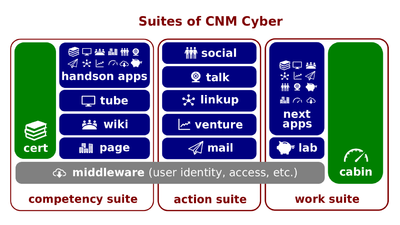Difference between revisions of "Microservices at Cloud"
(Created page with "400px|thumb|right|[[CNM Cyber]]Microservices at Cloud (hereinafter, the ''Lectio'') is the lesson part of the '''Soft behind CNM Clou...") |
|||
| (29 intermediate revisions by 2 users not shown) | |||
| Line 1: | Line 1: | ||
| − | [[File:Cnm-digital.png|400px|thumb|right|[[ | + | [[File:Cnm-digital.png|400px|thumb|right|[[CNMCyber suite]]s]][[Microservices at Cloud]] (hereinafter, the ''Lectio'') is the [[lectio|lesson part]] of the '''[[Soft behind CNM Cloud]]''' [[lesson]] that introduces its participants to [[Opplet]]. This ''lesson'' belongs to the [[Introduction to CNM Cloud]] session of [[EmployableU Concepts]]. |
==Content== | ==Content== | ||
| − | The predecessor [[lectio]] is [[ | + | The predecessor [[lectio]] is [[Engines and Organizers]]. |
| − | === | + | ===Script=== |
| + | :The concept of [[microservice architecture]] or, simply, [[microservices]], looks like similar to the [[service-oriented architecture]] ([[SOA]]) one. However, there are many differences, from which just two are mentioned here: | ||
| + | |||
| + | :First of all, the scopes vary. [[Microservices]] can be useful to design one [[software application]]. Vice versa, ''SOA'' is used to organize all the [[end-user application]]s of [[Opplet]]. | ||
| − | + | :Secondly, [[microservices]] lack the [[middleware]] layer that unifies all the [[software system]]s. They rely on lightweight unorganized communication messages instead. | |
| − | : | ||
| − | : | + | :[[CNMCyber Team]] adopts [[commercial off-the-shelf]] ([[COTS]]) [[software solution]]s as they are. Some of them, like [[Jitsi]], may deploy [[microservices]]. |
| − | : | + | :[[CNM Cabin]] and [[WorldOpp Middleware]] are the only custom-written [[software solution]]s of [[Opplet]]. Today, they use the [[layered architecture]], which is also known as [[Monolithic architecture|monolith]]. Nevertheless, the ''Team'' plans to re-build these solutions adopting [[microservices]]. |
| − | : | + | ===Key terms=== |
| + | :[[Microservice architecture]] ([[microservices]]) | ||
| − | : | + | ===Closing=== |
| + | Select True/False: | ||
| + | :[[Jitsi]] is one of the [[commercial off-the-shelf]] and [[open source]] [[software solution]]s adopted by [[CNMCyber Team]] --- T/F | ||
| − | |||
| − | '''[[What | + | '''[[What CNM Farms Are]]''' is the successor [[lectio]]. |
==Questions== | ==Questions== | ||
| − | |||
| − | |||
| − | |||
| − | |||
| − | |||
===Placement entrance exam=== | ===Placement entrance exam=== | ||
Latest revision as of 09:27, 15 November 2023
Microservices at Cloud (hereinafter, the Lectio) is the lesson part of the Soft behind CNM Cloud lesson that introduces its participants to Opplet. This lesson belongs to the Introduction to CNM Cloud session of EmployableU Concepts.
Content
The predecessor lectio is Engines and Organizers.
Script
- The concept of microservice architecture or, simply, microservices, looks like similar to the service-oriented architecture (SOA) one. However, there are many differences, from which just two are mentioned here:
- First of all, the scopes vary. Microservices can be useful to design one software application. Vice versa, SOA is used to organize all the end-user applications of Opplet.
- Secondly, microservices lack the middleware layer that unifies all the software systems. They rely on lightweight unorganized communication messages instead.
- CNMCyber Team adopts commercial off-the-shelf (COTS) software solutions as they are. Some of them, like Jitsi, may deploy microservices.
- CNM Cabin and WorldOpp Middleware are the only custom-written software solutions of Opplet. Today, they use the layered architecture, which is also known as monolith. Nevertheless, the Team plans to re-build these solutions adopting microservices.
Key terms
Closing
Select True/False:
- Jitsi is one of the commercial off-the-shelf and open source software solutions adopted by CNMCyber Team --- T/F
What CNM Farms Are is the successor lectio.
